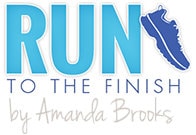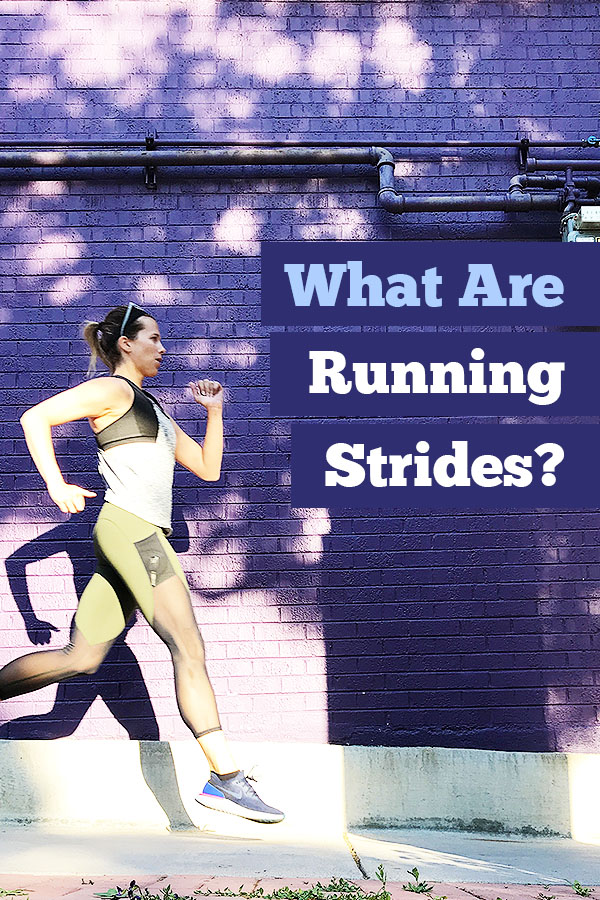Running strides can be a confusing workout description for many runners. Maybe you’ve seen this term on your training plan or heard the it thrown around in talking about speed work, but aren’t 100% sure if you’re doing them right.
No worries, runners have an entire vocabulary that we don’t always realize isn’t completely understood by both new and long time runners!
Running strides can provide a ton of benefits to not just beginners, but even more experienced runners looking to improve their running efficiency.
Learn exactly what they are, why you should do them, and exactly how to incorporate running strides into your running routine with my complete guide.
What are Running Strides?
A stride is a fast running effort over short distances of around 50m to 100m. It’s not a full-out sprint, but rather a methodical buildup to a faster pace that emphasizes proper form.
As a result, strides should not be performed at max speed or even at maximum effort. A perceived RPE of 7 to 8 or an effort of 85% of your maximum speed should be your goal. They allow you to spend time running at a faster pace without the recovery needed from an interval workout.
Strides are also referred to as striders, stride-outs, or accelerations.
- Depending on your skills and fitness level, one stride should take you roughly 20-30 seconds.
- You can begin with three strides and increase to six strides after four to six weeks of consistently incorporating them into your running routine.
- Between each stride, walk or stand for about 90 to 120 seconds to catch your breath.
- Below I’ll tell you exactly how to do them!
Running strides is not an aerobic workout, so don’t rush through them. In fact, decreasing the recovery period provides no additional benefits and won’t allow you to experience the benefits there are to running strides.
Strides are an excellent way to increase your running efficiency and can also serve as a great quick speed workout for new runners.
Why Should You Do Running Strides?
Running strides can provide a lot of benefits to just about any type of runner; from beginner runners to marathon runners, there is something you can gain by adding them to your training routine.
One of the reasons, you often see a workout during race week of 3 easy miles + 5 strides is because they’re an effective way to get in a little speed without taxing the body.
I wouldn’t consider them a speed training session, more like a running drill to add to the end of your workout.
Strides can improve your running balance and form, which can lower your risk of injury, and help you warm up before a big race.
When the race starts, it can allow you to quickly pick up the pace of the race without running the risk of being hurt since it can warm up your muscles, start to slightly increase your heart rate, and loosen up your joints and tendons.
However, as a pre-race activity, they’re only recommended for short distance races such as 5K or 10K; you’re better off conserving that energy before a marathon, on the other hand.
Other things these short bursts allow you to do include:
- Practicing foot turnover, instead of reaching for the next footfall to go faster
- Helps shake off some cobwebs from easy running
- They are so short they won’t shoot up your heart rate
- Improve your running cadence
- Provides a great dynamic stretch
- Helps beginners transition to faster workouts.
In fact, LHR runners could throw in 3 or 4 at the end of a run each week if desired. It’s a nice way to feel like you’re not always running at that slow pace and know that you will be able to pick up the speed when needed.
Do Strides Make You Faster?
Yes. A lot of top athletes swear by including them and they’re a very good way for new runners to begin introducing speed without intimidation or going too far and risking injury.
Think of it this way… if you do these even 1 time per week and you do 5 reps. That’s 1 minute of running say 2-3 minutes faster than you would in any other run. This is over time teaching your body how to adapt to that feeling.
Elite level athletes will build up to say 20 reps and do it a few times per week, so they are getting 5-6 minutes at that high speed without the intensity.
Where Can I Start Running Strides?
You can run strides practically anywhere. All you need is a clear area to run that’s around 100 meters in length. Let’s look at some of the top options you have:
Track
Running strides on a track is a popular choice for many runners. Tracks provide a measured distance, typically 400 meters for one lap, which allows for precise and consistent training.
The flat, well-maintained surface of a track offers optimal conditions for focusing on your form and speed.
Grass Field
Running strides on a grass field can be beneficial for several reasons. The softer surface reduces impact on your joints and muscles, making it a gentler option for those prone to injury or seeking a lower-impact workout.
Grass also challenges your stability and balance, as it requires more engagement from your stabilizing muscles. But be mindful of the terrain and make sure the field is even and free from hazards.
Open Road or Trail
If you prefer a more natural and dynamic environment, running strides on an open road or trail can be a great choice.
This option allows you to incorporate strides into your regular running route, making them seamlessly integrated into your training. This is what I prescribe to 90% of our athletes, so there is no excuse not to do them.
Running strides on varied terrain can also help develop adaptability and prepare you for different race conditions.
Treadmill
While outdoor running is often preferred, running strides on a treadmill can be a convenient alternative, especially when weather conditions or access to suitable outdoor locations are limited.
Treadmills offer a controlled environment where you can adjust speed and incline according to your training needs.
As someone who loves treadmill running, I will say this is my least favorite place to do strides. I don’t think it feels as natural to ramp up and down.
How To Do Running Strides?
Great now we know why they show up on training plans, but how do we do them correctly?
First, find a predictably flat surface that is long enough to run fast for 30 seconds while doing strides. If you have access to a track, that’s great, but if not, try a dead-end street (or a parking lot) away from traffic or even a long stretch of grass in a local park to use as a starting point.
Next, make sure you know what a stride is versus what it’s not. When someone starts assigning intervals like 8 x 30 seconds, that is no longer a stride.
Strides are generally done after you finish your run (or before a hard speed session) and look like this:
- Short relaxed sprint
- Shorter than .1 mile (yes SHORT)
- It’s a quick pick-up, then back to recovery
- 85% effort, but everything stays relaxed, no straining
- You’ll take a full recovery between strides, which could mean 2 minutes of walking or easy jogging
- Think of quick feet, not longer strides
- Think about squeezing your glutes
Don’t think of this as a time where you’re trying to beat a previous time or GET FASTER. This is a drill that will help you to improve speed but isn’t a workout. Don’t time it, just do the short burst and then recover and go again.
It shouldn’t feel like sprinting, but more like a controlled fast pace. When you’re about three-quarters of the way down the runway distance, gradually slow down by shortening your stride until you’re walking.
If you’re running based on time, your total stride should be roughly 30 seconds, which includes 10 seconds of easy running, 15 seconds of increasing stride length, and 5 seconds of deceleration.
How Many Strides Should You Do?
In general, there’s no need to do more than 3-6 strides for most runners. You can start to incorporate them weekly at the end of easy or long runs, once you’ve established a solid running base.
These are different than intervals where you run a set distance for a set time, with a set amount of recovery. Instead, remember you’re focusing on doing a short pick up of speed to practice that feeling and then walking to recover.
When Should You Do Strides?
Most often you’ll see them prescribed as something to do AFTER you finish an easy run. However, some coaches like to include them in the middle of a longer mid-week easy run.
Or they can also be a great part of your warm up prior to a hard speed workout. If you’ve done your dynamic warm up and some drills, then a light jog followed by 3-5 strides can ensure you are ready for some hard fast intervals.
The benefit is the same, just a different way of working out. Doing them during a longer run can help to simply switch gears and sometimes bring a little life back to your legs if they’re feeling heavy.
Strides Workout (Running Strides Drills)
Running strides are an essential training tool for runners of all levels, helping to improve speed, form, and efficiency. Do a dynamic warm-up before each of these stride drills :
1. Beginner Strides Drill
If you’re new to running strides, it’s crucial to start with the basics. These drills will focus on building a foundation of proper form and control.
- Find a flat, open space, preferably a track or a grassy field.
- Start with a slow jog and gradually increase your speed to a hard pace.
- Begin the stride by taking shorter, quicker steps, focusing on maintaining an upright posture.
- Aim to reach your fastest pace within 50 to 100 meters, but avoid sprinting at your maximum effort.
- As you complete each stride, decelerate gradually to a slow jog and then walk to recover.
- Repeat the strides 3-5 times, allowing adequate rest between each repetition.
Pay attention to your arm swing, keeping your elbows bent at approximately 90 degrees and swinging them back and forth in a controlled manner. Focus on landing mid-foot or forefoot, ensuring a smooth and efficient transfer of energy.
Maintain an upright posture, with your chest lifted and shoulders relaxed. And make sure to stay relaxed throughout the stride, avoiding excessive tension in your muscles.
2. Intermediate Strides Drill
Once you have mastered the beginner strides drill, you can progress to more challenging exercises to further develop your speed and running economy.
- Choose a slightly longer distance, ranging from 80 to 120 meters, to challenge your speed and endurance.
- Start with a comfortable jog, gradually increasing your speed until you reach a controlled, fast pace.
- Emphasize a powerful push-off with each stride, propelling yourself forward. Thinking about that forward lean.
- Focus on maintaining a smooth and efficient stride pattern, keeping your cadence quick.
- Execute 8-10 repetitions of the strides, allowing sufficient recovery time between each repetition.
When doing this strides drill, concentrate on maintaining a relaxed upper body, avoiding excessive tension in your neck, shoulders, and arms. Work on refining your foot strike, ensuring a balanced landing and quick turnover.
Plus, engage your core muscles to stabilize your body and maintain proper alignment. It’s important to practice controlled breathing, inhaling deeply through your nose and exhaling forcefully through your mouth.
3. Advanced Strides Drill
For experienced runners seeking to maximize their stride efficiency and speed, advanced strides drills provide an intense training stimulus.
- Select a distance between 100 and 150 meters, challenging your ability to sustain a faster pace.
- Start with a brisk jog, gradually transitioning into a controlled, near-sprint effort.
- Maintain a consistent, powerful stride, focusing on generating maximum power with each step.
- Push your limits, aiming to reach close to your maximum speed without sacrificing proper form.
- Perform up to 20 repetitions of the strides, allowing sufficient recovery between each repetition.
When doing this strides drill, drive your knees forward and maintain a strong arm swing to enhance power generation. Concentrate on maintaining an efficient forward lean while avoiding excessive tilting. Keep your gaze forward, focusing on a fixed point ahead to enhance stability and alignment.
All right, short and sweet just like striders!! I hope this helps to explain this running term to you!
Before you go, here are a few other running terms you might need to know in the future:
And if you’re serious about getting faster remember that one of the biggest components is runner STRENGTH TRAINING. You must have enough strength in your glutes and hips to provide power in your stride, keep your body in proper alignment and not overwork weaker muscles.
You also need good foot strength so you can spring off the ground.
Running faster is about a combination of things from your easy runs to running strides to the key cross training.
Other ways to connect with Amanda
Instagram Daily Fun: RunToTheFinish
Facebook Community Chatter: RunToTheFinish
Sign Up to Receive a Weekly Newsletter with Top Running Tips




 Everlywell Review: How Do These At-Home Blood Tests Work?
Everlywell Review: How Do These At-Home Blood Tests Work?
